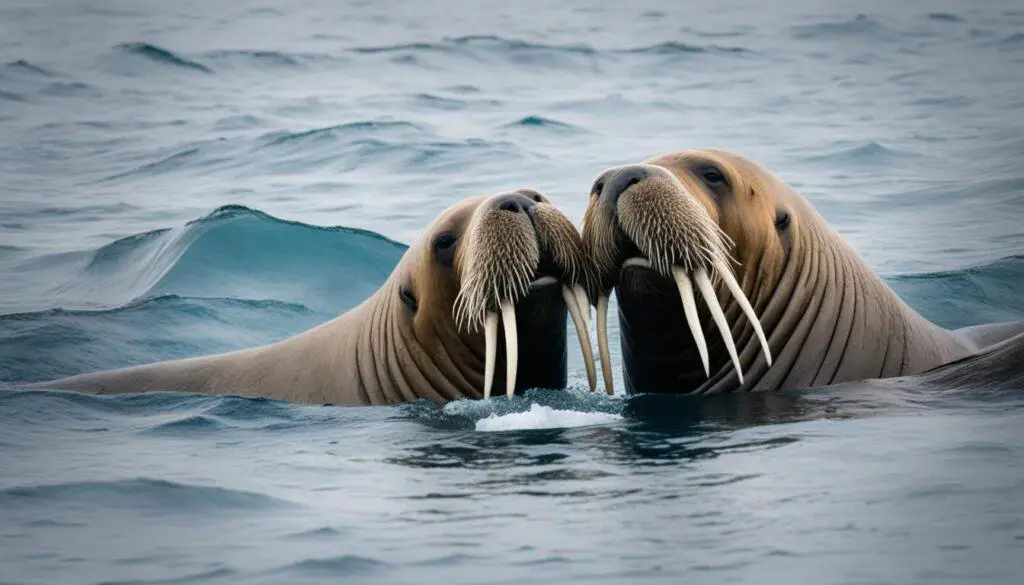Walrus reproduction is a fascinating topic that shows how these marine mammals live and interact. It’s about their mating rituals and how they organize themselves. We’ll look into how walruses mate and carry their young, which is key to their survival.
Let’s start by understanding the basics of walrus reproduction. This includes their mating habits and how long they carry their young. Knowing this helps us see why these behaviors are crucial for their survival.
Understanding Walrus Biology
Learning about walrus biology is key to understanding their mating habits. Their unique traits help them reproduce successfully.
Physical Characteristics and Sexual Maturity
Male walruses become sexually mature between eight to ten years old. They usually start reproducing well around 15 years, when they reach their full size. Females mature a bit earlier, between five to six years, but they start reproducing successfully closer to ten years old.
The impressive size of male walruses, weighing up to 3,750 pounds, is crucial in their mating rituals. Their large tusks are used for defense and mating. Knowing these traits helps us understand walrus reproduction better.
Differences Between Male and Female Walruses
Male and female walruses have different reproductive strategies. While males don’t migrate much, females do so annually for mating. This shows the complexity in walrus biology.
| Characteristic | Male Walrus | Female Walrus |
|---|---|---|
| Weight | Up to 3,750 pounds | Up to 2,000 pounds |
| Sexual Maturity | 8-10 years | 5-6 years |
| Successful Reproduction Starts | Around 15 years | About 10 years |
| Tusks | Large and prominent, aids in mating rituals | Shorter, used for defense |
| Migration Patterns | Less frequent | Annual migrations for mating |
Walrus Reproduction Behavior
Walrus reproduction behavior is quite interesting. During mating season, males show off to attract females and beat other males. These actions affect not just who mates but also their social group dynamics.
Male Display and Competition
Males make loud sounds to call females from far away. These sounds show they’re fit and in charge. They also fight each other, using their big tusks, to prove strength. This helps decide who gets to mate.
Female Selection Criteria
Females pick their mates based on how well males sound and fight. A walrus’s ability to make loud sounds and fight well can really help him win a mate. The best males at both get more mates. This choice affects not just their love lives but also the balance in walrus populations.
How do walruses reproduce?
The walrus breeding cycle is key to keeping this species going. It shows us how walruses live and interact with each other. They mate mostly underwater, under the ice, which is a special place for them.
During their breeding time, the estrus phase is vital. Female walruses can only be fertile from December to March. This is when they mate and help grow the next generation. Males compete to show they are the best mates.
Not all female walruses are ready to mate at once. Some might already be pregnant, which means fewer chances for others to mate. This shows how important reproduction is to their social life.
| Reproductive Aspect | Details |
|---|---|
| Duration of Estrus | Occurs once a year, primarily from December to March |
| Underwater Mating | Copulation occurs beneath pack ice, a unique adaptation |
| Pregnancy Rate | Proportion of pregnant females affects mating availability |
| Male Competition | Males compete for female attention through displays of strength |

Walrus Mating Habits
Learning about walrus mating habits helps us understand their reproductive cycle better. They mate seasonally, which affects their population size. Female walruses mate once every two years because their pregnancy lasts about 15 to 16 months.
This long pregnancy includes a special phase called delayed implantation. It helps them wait for the best time to have their calves.
Seasonal Mating Patterns
In late winter to early spring, female walruses meet on ice floes to mate. This is the perfect place for them to find a mate. They listen to the sounds of potential partners to choose the best one.
This careful choice is important because their pregnancy lasts so long.
Frequency of Mating
Walruses don’t mate often because they wait a long time between pregnancies. This makes them more sensitive to changes in their environment. Knowing this helps us understand the challenges they face in their Arctic home.
FAQ
How do walruses reproduce?
Walruses reproduce through a complex process. Males fight for dominance and use sounds to attract females. This happens mainly from December to March.
What are walrus mating habits?
Males show off with loud sounds to get the females’ attention. They also fight to be the top male. Females pick a mate once every two years.
What is the gestation period for walruses?
Walruses are pregnant for about 15 to 16 months. They delay implanting the embryo at first. This ensures the best time for the calf’s birth.
How do walruses select their mates?
Females choose mates based on how loud and strong males sound and act. They pick the top males who show they can compete well.
When do walruses mate?
Walruses mate from late winter to early spring, from December to March. This time is key for their reproduction and fits their environment.
Do male and female walruses have different migration patterns?
Yes, they do. Females move every year to breed. Males stay where they can show off to find mates, which helps their mating plans.
How often do walruses reproduce?
Female walruses have a calf every two years. This is because they are pregnant for a long time and need to care for their young.
What role do vocal displays play in walrus reproduction?
Vocal displays are very important. Males make sounds like bells and clicks to show they’re ready and to attract females. This helps them mate successfully.







